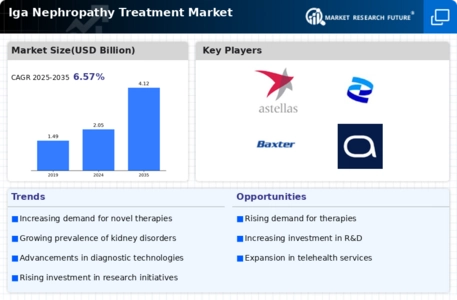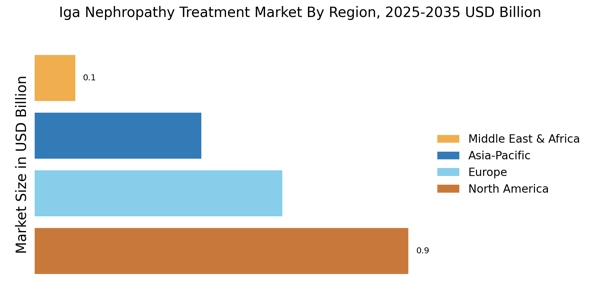Increased Awareness and Education
The rising awareness and education regarding Iga nephropathy are pivotal in shaping the Iga Nephropathy Treatment Market. Efforts by healthcare organizations and advocacy groups to educate both patients and healthcare professionals about the disease are gaining momentum. This increased awareness leads to earlier diagnosis and treatment, which is crucial for managing the condition effectively. Moreover, educational initiatives are likely to empower patients to seek timely medical intervention, thereby expanding the market for treatment options. As more individuals become informed about Iga nephropathy, the demand for effective therapies is expected to rise, further driving the growth of the Iga Nephropathy Treatment Market.
Collaborative Research Initiatives
Collaborative research initiatives among pharmaceutical companies, academic institutions, and healthcare organizations are fostering innovation in the Iga Nephropathy Treatment Market. These partnerships aim to accelerate the development of new therapies and improve existing treatment protocols. By pooling resources and expertise, stakeholders can conduct comprehensive studies that enhance understanding of the disease and its treatment. Such collaborations are likely to lead to breakthroughs in therapeutic options, which could significantly impact patient care. As research efforts intensify, the Iga Nephropathy Treatment Market is poised for growth, driven by the introduction of novel treatment strategies and improved patient outcomes.
Advancements in Treatment Modalities
Innovations in treatment modalities are significantly influencing the Iga Nephropathy Treatment Market. Recent advancements in pharmacological therapies, including the introduction of novel immunosuppressants and biologics, have shown promise in managing the disease. These new treatment options are designed to target the underlying mechanisms of Iga nephropathy, potentially improving patient outcomes. Additionally, the development of personalized medicine approaches allows for tailored therapies based on individual patient profiles, enhancing treatment efficacy. The market is witnessing a shift towards more effective and targeted therapies, which could lead to increased adoption rates among healthcare providers. As a result, the Iga Nephropathy Treatment Market is expected to experience substantial growth driven by these advancements.
Rising Prevalence of Iga Nephropathy
The increasing incidence of Iga nephropathy is a primary driver for the Iga Nephropathy Treatment Market. Recent estimates suggest that the condition affects approximately 2-3 individuals per 100,000 people annually, with a notable rise in cases reported in various regions. This growing prevalence necessitates the development of effective treatment options, thereby propelling market growth. As healthcare systems strive to address this rising burden, investments in research and innovative therapies are likely to increase. Furthermore, the awareness surrounding Iga nephropathy is gradually improving, leading to earlier diagnosis and treatment. This trend indicates a potential expansion of the patient population seeking therapeutic interventions, which could further stimulate the Iga Nephropathy Treatment Market.
Growing Investment in Healthcare Infrastructure
The expansion of healthcare infrastructure is a crucial driver for the Iga Nephropathy Treatment Market. Governments and private entities are increasingly investing in healthcare facilities and services, particularly in regions with a high prevalence of chronic diseases. This investment is aimed at improving access to diagnostic and treatment options for patients suffering from Iga nephropathy. Enhanced healthcare infrastructure facilitates better patient management and follow-up care, which is essential for chronic conditions like Iga nephropathy. Furthermore, the establishment of specialized nephrology centers is likely to provide focused care, thereby improving treatment outcomes. As healthcare systems evolve, the Iga Nephropathy Treatment Market stands to benefit from these infrastructural developments.


















Leave a Comment